Analyzing Strategies of Multi-Business Organizations: Tesco, Samsung
VerifiedAdded on 2023/01/13
|6
|1489
|73
Essay
AI Summary
This essay examines the strategic choices of multi-business organizations, focusing on how companies like Tesco, Samsung, and the Co-operative Group manage their diverse business activities. The introduction defines multi-business organizations as entities comprising several subsidiaries under a parent company, emphasizing multi-profit center strategies, long-term objectives, and resource allocation. The discussion analyzes the advantages and disadvantages of such structures, including diversification benefits versus increased management costs and potential lack of focus. Case studies of Tesco, Samsung, and the Co-operative Group are presented to illustrate various strategic approaches, such as Tesco's expansion into non-food products and international grocery markets, Samsung's flexible and dynamic strategies involving product reinvention and market exploitation, and the Co-operative Group's focus on financial services and retail. The essay explores the opportunities and challenges associated with these strategies, such as competitor restrictions and the need for efficient management across diverse business sectors. The conclusion summarizes the importance of strategic decisions in effectively managing multi-business operations, highlighting the insights gained from the case studies.
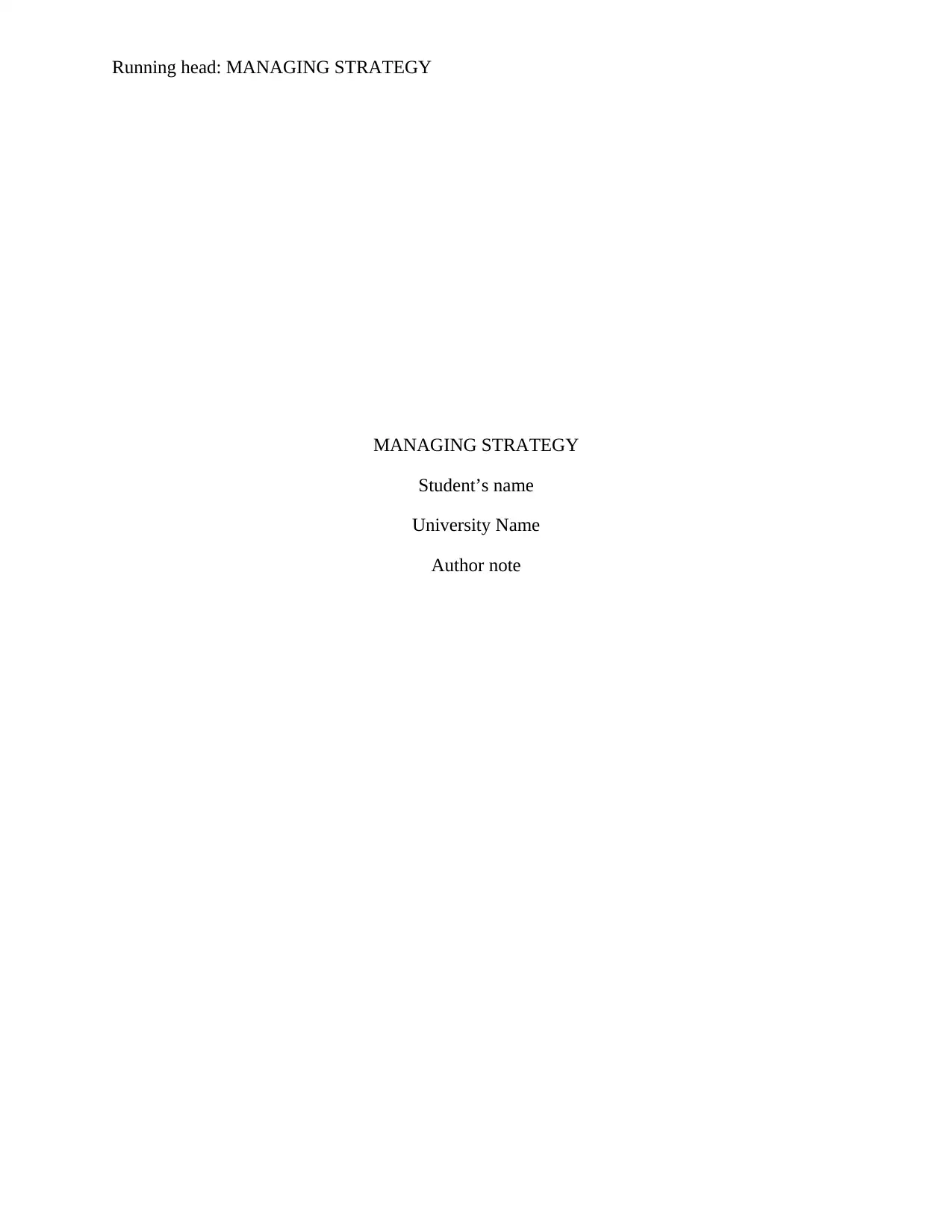
Running head: MANAGING STRATEGY
MANAGING STRATEGY
Student’s name
University Name
Author note
MANAGING STRATEGY
Student’s name
University Name
Author note
Paraphrase This Document
Need a fresh take? Get an instant paraphrase of this document with our AI Paraphraser
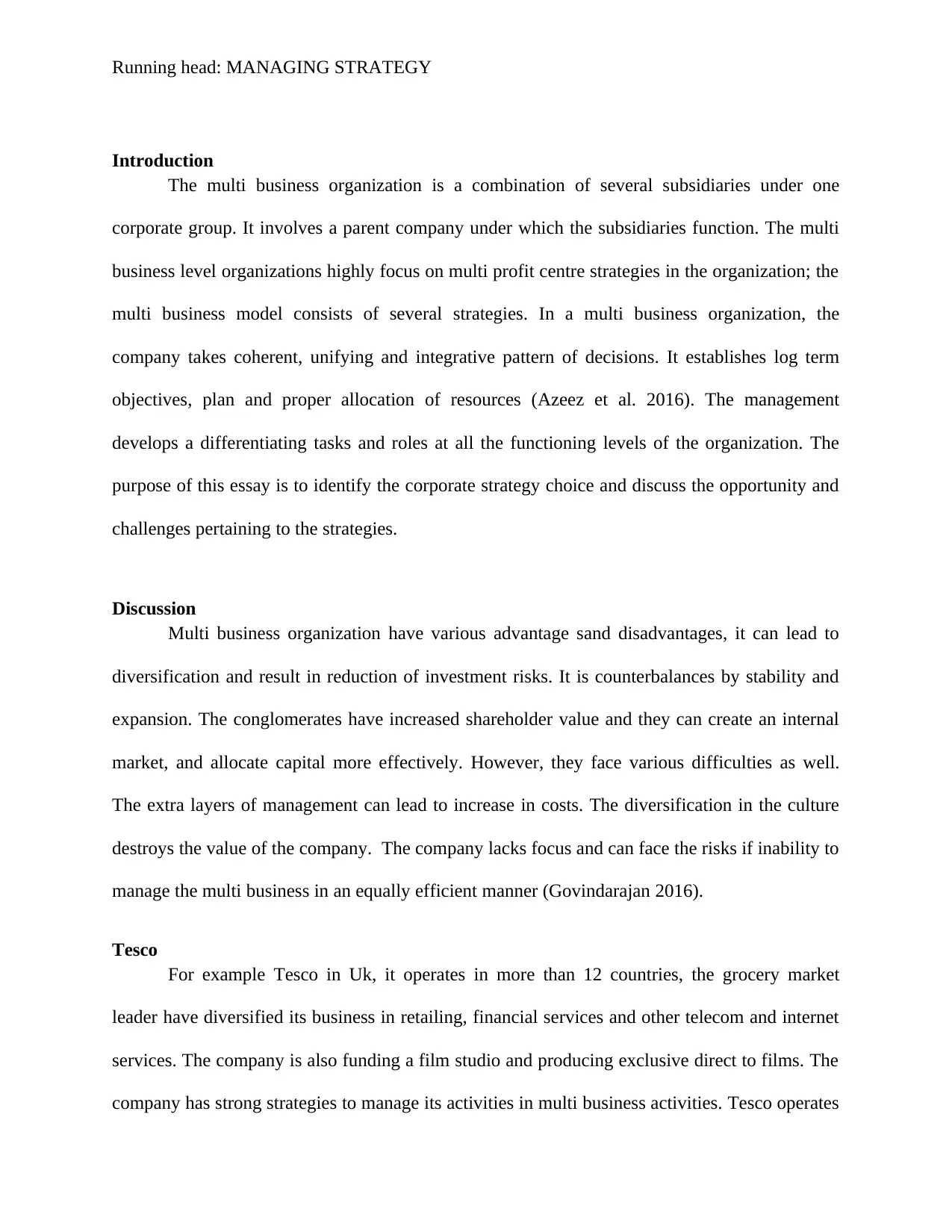
Running head: MANAGING STRATEGY
Introduction
The multi business organization is a combination of several subsidiaries under one
corporate group. It involves a parent company under which the subsidiaries function. The multi
business level organizations highly focus on multi profit centre strategies in the organization; the
multi business model consists of several strategies. In a multi business organization, the
company takes coherent, unifying and integrative pattern of decisions. It establishes log term
objectives, plan and proper allocation of resources (Azeez et al. 2016). The management
develops a differentiating tasks and roles at all the functioning levels of the organization. The
purpose of this essay is to identify the corporate strategy choice and discuss the opportunity and
challenges pertaining to the strategies.
Discussion
Multi business organization have various advantage sand disadvantages, it can lead to
diversification and result in reduction of investment risks. It is counterbalances by stability and
expansion. The conglomerates have increased shareholder value and they can create an internal
market, and allocate capital more effectively. However, they face various difficulties as well.
The extra layers of management can lead to increase in costs. The diversification in the culture
destroys the value of the company. The company lacks focus and can face the risks if inability to
manage the multi business in an equally efficient manner (Govindarajan 2016).
Tesco
For example Tesco in Uk, it operates in more than 12 countries, the grocery market
leader have diversified its business in retailing, financial services and other telecom and internet
services. The company is also funding a film studio and producing exclusive direct to films. The
company has strong strategies to manage its activities in multi business activities. Tesco operates
Introduction
The multi business organization is a combination of several subsidiaries under one
corporate group. It involves a parent company under which the subsidiaries function. The multi
business level organizations highly focus on multi profit centre strategies in the organization; the
multi business model consists of several strategies. In a multi business organization, the
company takes coherent, unifying and integrative pattern of decisions. It establishes log term
objectives, plan and proper allocation of resources (Azeez et al. 2016). The management
develops a differentiating tasks and roles at all the functioning levels of the organization. The
purpose of this essay is to identify the corporate strategy choice and discuss the opportunity and
challenges pertaining to the strategies.
Discussion
Multi business organization have various advantage sand disadvantages, it can lead to
diversification and result in reduction of investment risks. It is counterbalances by stability and
expansion. The conglomerates have increased shareholder value and they can create an internal
market, and allocate capital more effectively. However, they face various difficulties as well.
The extra layers of management can lead to increase in costs. The diversification in the culture
destroys the value of the company. The company lacks focus and can face the risks if inability to
manage the multi business in an equally efficient manner (Govindarajan 2016).
Tesco
For example Tesco in Uk, it operates in more than 12 countries, the grocery market
leader have diversified its business in retailing, financial services and other telecom and internet
services. The company is also funding a film studio and producing exclusive direct to films. The
company has strong strategies to manage its activities in multi business activities. Tesco operates
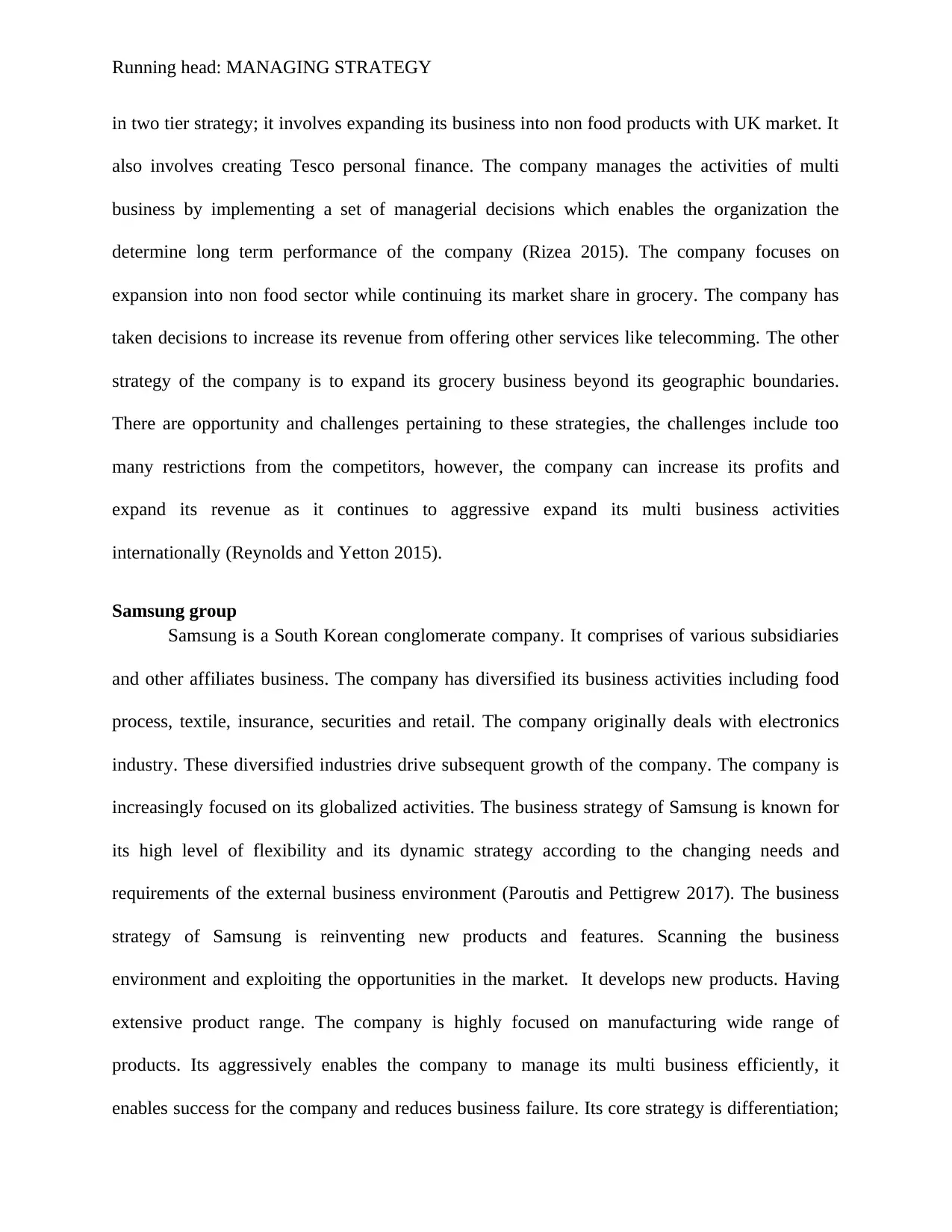
Running head: MANAGING STRATEGY
in two tier strategy; it involves expanding its business into non food products with UK market. It
also involves creating Tesco personal finance. The company manages the activities of multi
business by implementing a set of managerial decisions which enables the organization the
determine long term performance of the company (Rizea 2015). The company focuses on
expansion into non food sector while continuing its market share in grocery. The company has
taken decisions to increase its revenue from offering other services like telecomming. The other
strategy of the company is to expand its grocery business beyond its geographic boundaries.
There are opportunity and challenges pertaining to these strategies, the challenges include too
many restrictions from the competitors, however, the company can increase its profits and
expand its revenue as it continues to aggressive expand its multi business activities
internationally (Reynolds and Yetton 2015).
Samsung group
Samsung is a South Korean conglomerate company. It comprises of various subsidiaries
and other affiliates business. The company has diversified its business activities including food
process, textile, insurance, securities and retail. The company originally deals with electronics
industry. These diversified industries drive subsequent growth of the company. The company is
increasingly focused on its globalized activities. The business strategy of Samsung is known for
its high level of flexibility and its dynamic strategy according to the changing needs and
requirements of the external business environment (Paroutis and Pettigrew 2017). The business
strategy of Samsung is reinventing new products and features. Scanning the business
environment and exploiting the opportunities in the market. It develops new products. Having
extensive product range. The company is highly focused on manufacturing wide range of
products. Its aggressively enables the company to manage its multi business efficiently, it
enables success for the company and reduces business failure. Its core strategy is differentiation;
in two tier strategy; it involves expanding its business into non food products with UK market. It
also involves creating Tesco personal finance. The company manages the activities of multi
business by implementing a set of managerial decisions which enables the organization the
determine long term performance of the company (Rizea 2015). The company focuses on
expansion into non food sector while continuing its market share in grocery. The company has
taken decisions to increase its revenue from offering other services like telecomming. The other
strategy of the company is to expand its grocery business beyond its geographic boundaries.
There are opportunity and challenges pertaining to these strategies, the challenges include too
many restrictions from the competitors, however, the company can increase its profits and
expand its revenue as it continues to aggressive expand its multi business activities
internationally (Reynolds and Yetton 2015).
Samsung group
Samsung is a South Korean conglomerate company. It comprises of various subsidiaries
and other affiliates business. The company has diversified its business activities including food
process, textile, insurance, securities and retail. The company originally deals with electronics
industry. These diversified industries drive subsequent growth of the company. The company is
increasingly focused on its globalized activities. The business strategy of Samsung is known for
its high level of flexibility and its dynamic strategy according to the changing needs and
requirements of the external business environment (Paroutis and Pettigrew 2017). The business
strategy of Samsung is reinventing new products and features. Scanning the business
environment and exploiting the opportunities in the market. It develops new products. Having
extensive product range. The company is highly focused on manufacturing wide range of
products. Its aggressively enables the company to manage its multi business efficiently, it
enables success for the company and reduces business failure. Its core strategy is differentiation;
⊘ This is a preview!⊘
Do you want full access?
Subscribe today to unlock all pages.

Trusted by 1+ million students worldwide
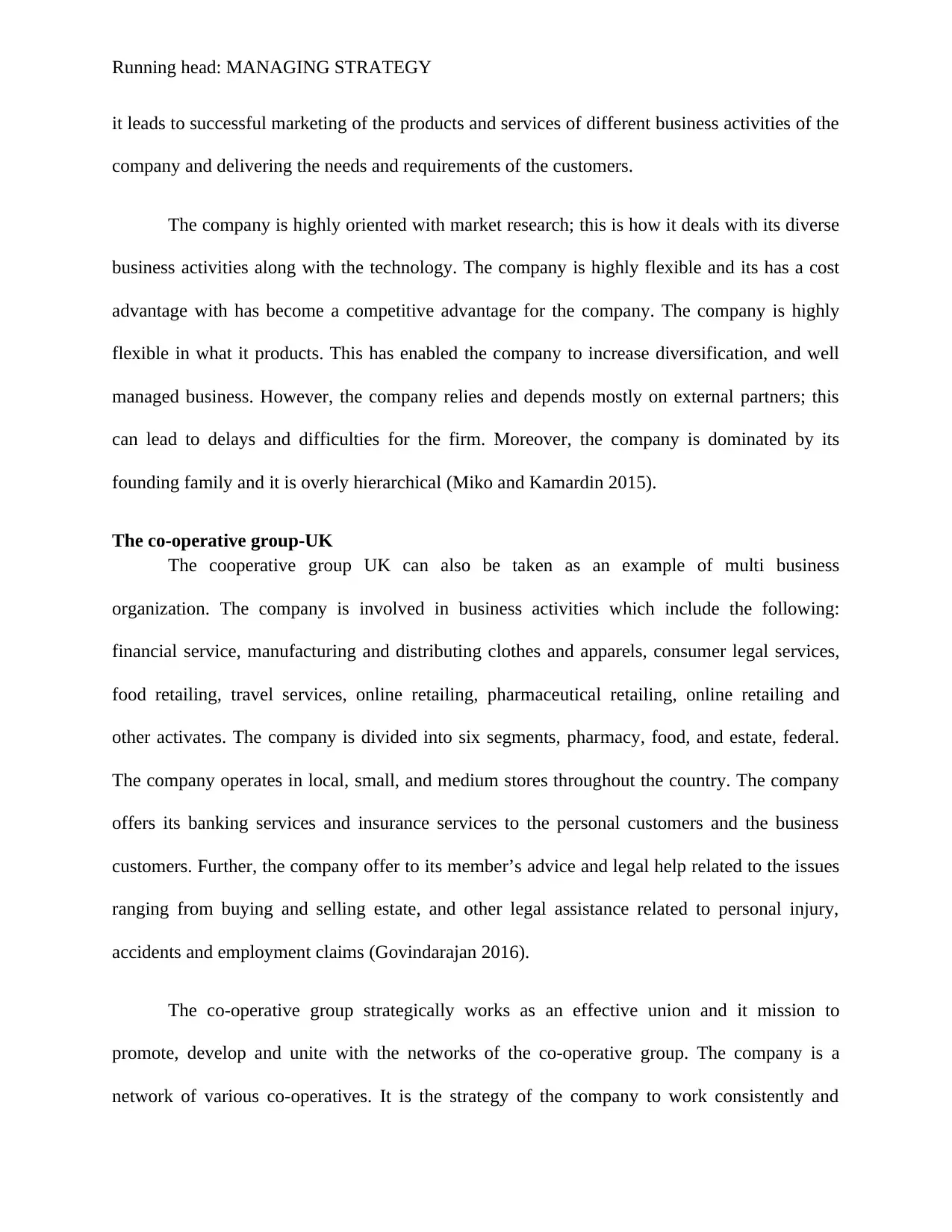
Running head: MANAGING STRATEGY
it leads to successful marketing of the products and services of different business activities of the
company and delivering the needs and requirements of the customers.
The company is highly oriented with market research; this is how it deals with its diverse
business activities along with the technology. The company is highly flexible and its has a cost
advantage with has become a competitive advantage for the company. The company is highly
flexible in what it products. This has enabled the company to increase diversification, and well
managed business. However, the company relies and depends mostly on external partners; this
can lead to delays and difficulties for the firm. Moreover, the company is dominated by its
founding family and it is overly hierarchical (Miko and Kamardin 2015).
The co-operative group-UK
The cooperative group UK can also be taken as an example of multi business
organization. The company is involved in business activities which include the following:
financial service, manufacturing and distributing clothes and apparels, consumer legal services,
food retailing, travel services, online retailing, pharmaceutical retailing, online retailing and
other activates. The company is divided into six segments, pharmacy, food, and estate, federal.
The company operates in local, small, and medium stores throughout the country. The company
offers its banking services and insurance services to the personal customers and the business
customers. Further, the company offer to its member’s advice and legal help related to the issues
ranging from buying and selling estate, and other legal assistance related to personal injury,
accidents and employment claims (Govindarajan 2016).
The co-operative group strategically works as an effective union and it mission to
promote, develop and unite with the networks of the co-operative group. The company is a
network of various co-operatives. It is the strategy of the company to work consistently and
it leads to successful marketing of the products and services of different business activities of the
company and delivering the needs and requirements of the customers.
The company is highly oriented with market research; this is how it deals with its diverse
business activities along with the technology. The company is highly flexible and its has a cost
advantage with has become a competitive advantage for the company. The company is highly
flexible in what it products. This has enabled the company to increase diversification, and well
managed business. However, the company relies and depends mostly on external partners; this
can lead to delays and difficulties for the firm. Moreover, the company is dominated by its
founding family and it is overly hierarchical (Miko and Kamardin 2015).
The co-operative group-UK
The cooperative group UK can also be taken as an example of multi business
organization. The company is involved in business activities which include the following:
financial service, manufacturing and distributing clothes and apparels, consumer legal services,
food retailing, travel services, online retailing, pharmaceutical retailing, online retailing and
other activates. The company is divided into six segments, pharmacy, food, and estate, federal.
The company operates in local, small, and medium stores throughout the country. The company
offers its banking services and insurance services to the personal customers and the business
customers. Further, the company offer to its member’s advice and legal help related to the issues
ranging from buying and selling estate, and other legal assistance related to personal injury,
accidents and employment claims (Govindarajan 2016).
The co-operative group strategically works as an effective union and it mission to
promote, develop and unite with the networks of the co-operative group. The company is a
network of various co-operatives. It is the strategy of the company to work consistently and
Paraphrase This Document
Need a fresh take? Get an instant paraphrase of this document with our AI Paraphraser
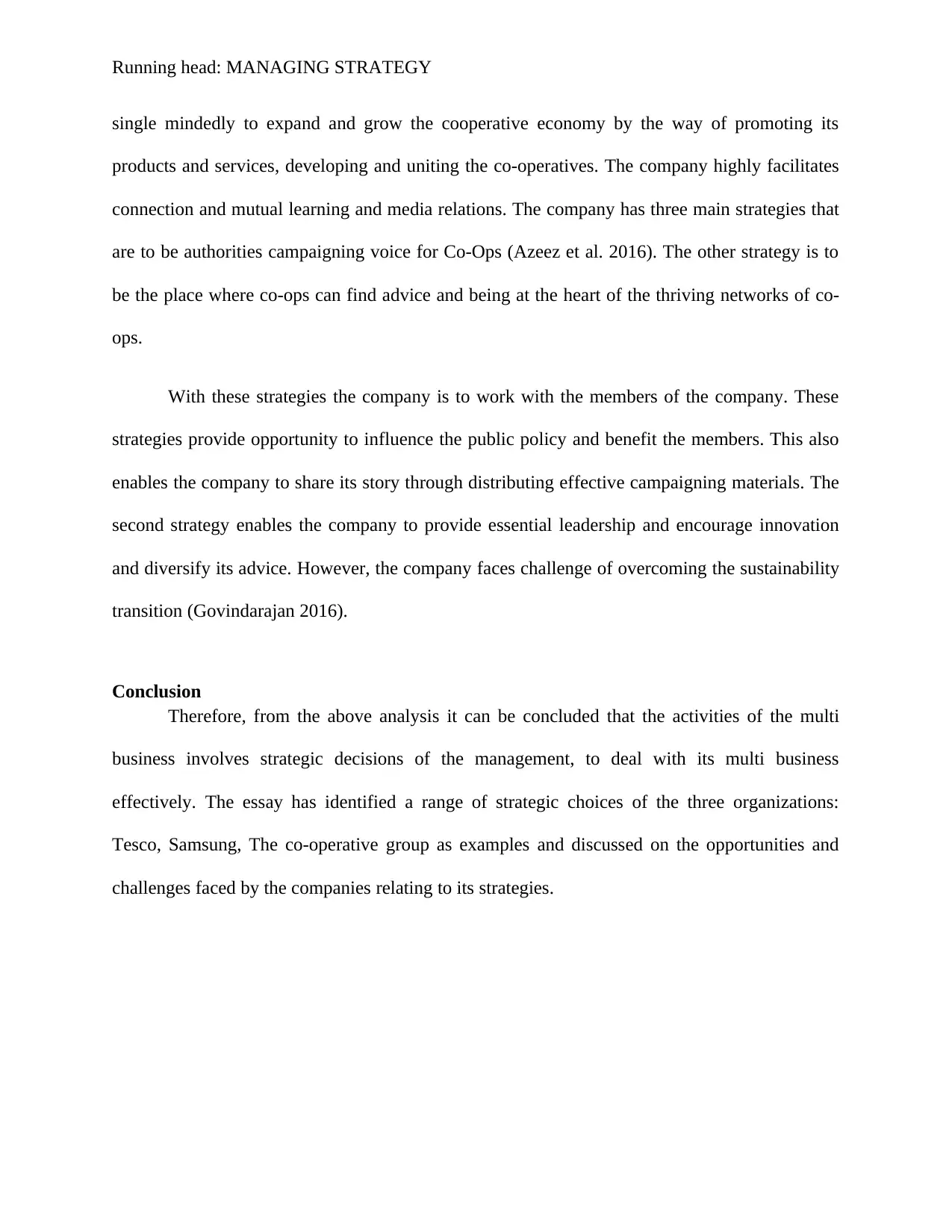
Running head: MANAGING STRATEGY
single mindedly to expand and grow the cooperative economy by the way of promoting its
products and services, developing and uniting the co-operatives. The company highly facilitates
connection and mutual learning and media relations. The company has three main strategies that
are to be authorities campaigning voice for Co-Ops (Azeez et al. 2016). The other strategy is to
be the place where co-ops can find advice and being at the heart of the thriving networks of co-
ops.
With these strategies the company is to work with the members of the company. These
strategies provide opportunity to influence the public policy and benefit the members. This also
enables the company to share its story through distributing effective campaigning materials. The
second strategy enables the company to provide essential leadership and encourage innovation
and diversify its advice. However, the company faces challenge of overcoming the sustainability
transition (Govindarajan 2016).
Conclusion
Therefore, from the above analysis it can be concluded that the activities of the multi
business involves strategic decisions of the management, to deal with its multi business
effectively. The essay has identified a range of strategic choices of the three organizations:
Tesco, Samsung, The co-operative group as examples and discussed on the opportunities and
challenges faced by the companies relating to its strategies.
single mindedly to expand and grow the cooperative economy by the way of promoting its
products and services, developing and uniting the co-operatives. The company highly facilitates
connection and mutual learning and media relations. The company has three main strategies that
are to be authorities campaigning voice for Co-Ops (Azeez et al. 2016). The other strategy is to
be the place where co-ops can find advice and being at the heart of the thriving networks of co-
ops.
With these strategies the company is to work with the members of the company. These
strategies provide opportunity to influence the public policy and benefit the members. This also
enables the company to share its story through distributing effective campaigning materials. The
second strategy enables the company to provide essential leadership and encourage innovation
and diversify its advice. However, the company faces challenge of overcoming the sustainability
transition (Govindarajan 2016).
Conclusion
Therefore, from the above analysis it can be concluded that the activities of the multi
business involves strategic decisions of the management, to deal with its multi business
effectively. The essay has identified a range of strategic choices of the three organizations:
Tesco, Samsung, The co-operative group as examples and discussed on the opportunities and
challenges faced by the companies relating to its strategies.
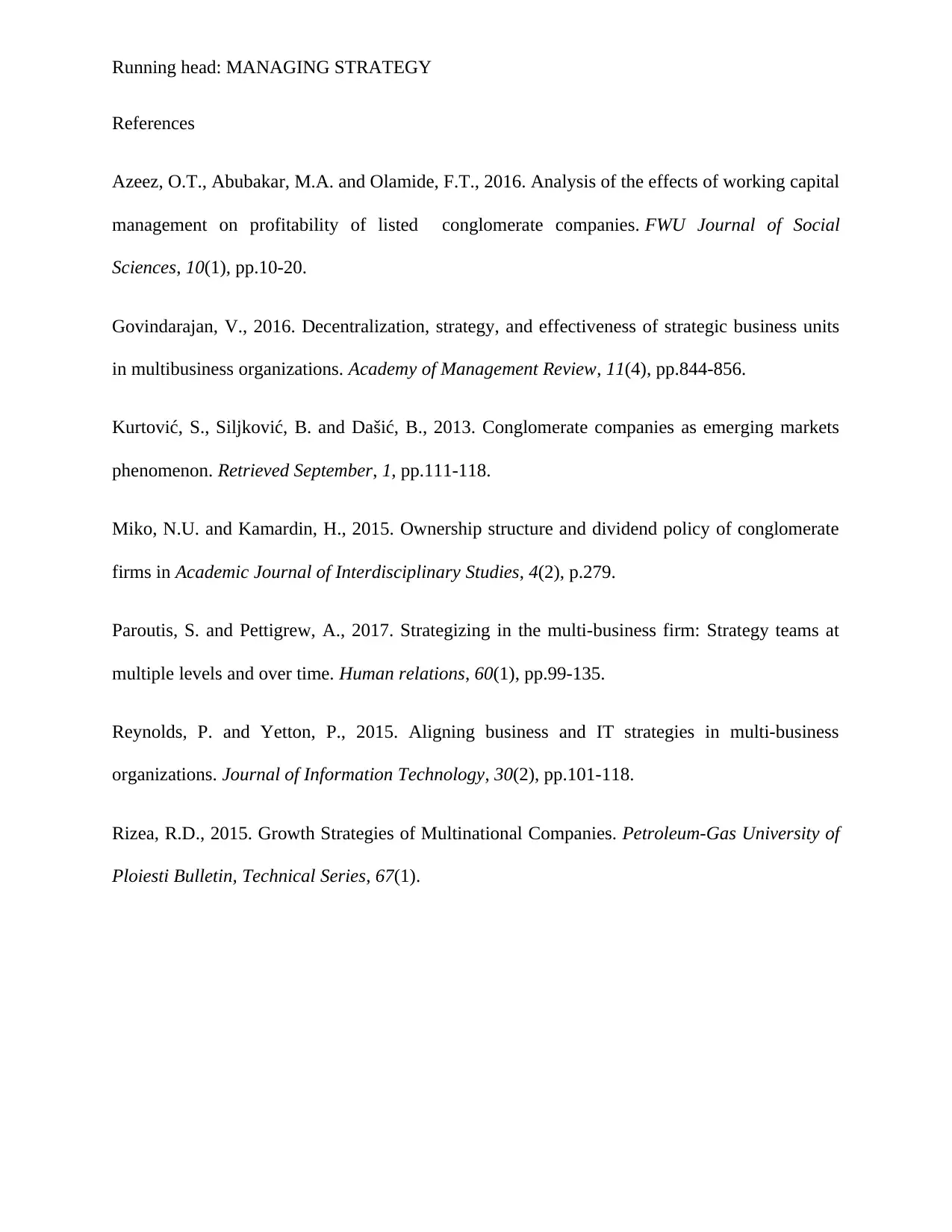
Running head: MANAGING STRATEGY
References
Azeez, O.T., Abubakar, M.A. and Olamide, F.T., 2016. Analysis of the effects of working capital
management on profitability of listed conglomerate companies. FWU Journal of Social
Sciences, 10(1), pp.10-20.
Govindarajan, V., 2016. Decentralization, strategy, and effectiveness of strategic business units
in multibusiness organizations. Academy of Management Review, 11(4), pp.844-856.
Kurtović, S., Siljković, B. and Dašić, B., 2013. Conglomerate companies as emerging markets
phenomenon. Retrieved September, 1, pp.111-118.
Miko, N.U. and Kamardin, H., 2015. Ownership structure and dividend policy of conglomerate
firms in Academic Journal of Interdisciplinary Studies, 4(2), p.279.
Paroutis, S. and Pettigrew, A., 2017. Strategizing in the multi-business firm: Strategy teams at
multiple levels and over time. Human relations, 60(1), pp.99-135.
Reynolds, P. and Yetton, P., 2015. Aligning business and IT strategies in multi-business
organizations. Journal of Information Technology, 30(2), pp.101-118.
Rizea, R.D., 2015. Growth Strategies of Multinational Companies. Petroleum-Gas University of
Ploiesti Bulletin, Technical Series, 67(1).
References
Azeez, O.T., Abubakar, M.A. and Olamide, F.T., 2016. Analysis of the effects of working capital
management on profitability of listed conglomerate companies. FWU Journal of Social
Sciences, 10(1), pp.10-20.
Govindarajan, V., 2016. Decentralization, strategy, and effectiveness of strategic business units
in multibusiness organizations. Academy of Management Review, 11(4), pp.844-856.
Kurtović, S., Siljković, B. and Dašić, B., 2013. Conglomerate companies as emerging markets
phenomenon. Retrieved September, 1, pp.111-118.
Miko, N.U. and Kamardin, H., 2015. Ownership structure and dividend policy of conglomerate
firms in Academic Journal of Interdisciplinary Studies, 4(2), p.279.
Paroutis, S. and Pettigrew, A., 2017. Strategizing in the multi-business firm: Strategy teams at
multiple levels and over time. Human relations, 60(1), pp.99-135.
Reynolds, P. and Yetton, P., 2015. Aligning business and IT strategies in multi-business
organizations. Journal of Information Technology, 30(2), pp.101-118.
Rizea, R.D., 2015. Growth Strategies of Multinational Companies. Petroleum-Gas University of
Ploiesti Bulletin, Technical Series, 67(1).
⊘ This is a preview!⊘
Do you want full access?
Subscribe today to unlock all pages.

Trusted by 1+ million students worldwide
1 out of 6
Related Documents
Your All-in-One AI-Powered Toolkit for Academic Success.
+13062052269
info@desklib.com
Available 24*7 on WhatsApp / Email
![[object Object]](/_next/static/media/star-bottom.7253800d.svg)
Unlock your academic potential
Copyright © 2020–2025 A2Z Services. All Rights Reserved. Developed and managed by ZUCOL.





